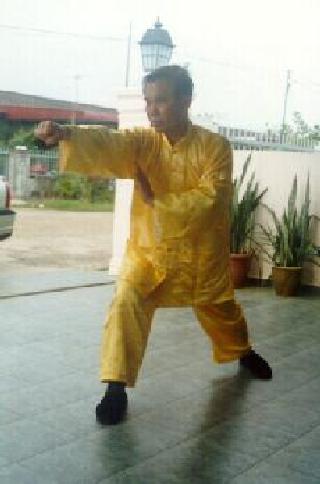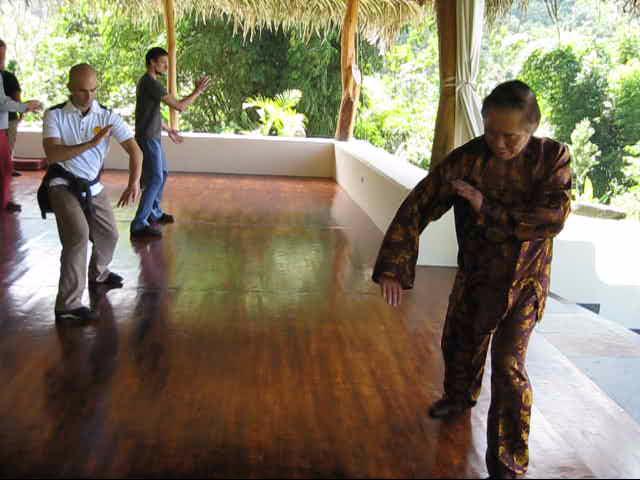SELECTION OF QUESTIONS AND ANSWERS
SEPTEMBER 2011 PART 3

Sukhavati -- The Western Paradise of Eternal Bliss
Question 1
What about non humans like devas and other higher beings, can they go to Sukhavati? If a deva wants to go to Sukhavati, can he study the Amitabha Sutra, make a vow and be reborn in Sukhavati?
— Ahsun, UK
Answer
Yes, higher beings, like devas, or heavenly beings, can be reborn in Sukhavati, the Western Paradise, if they fulfill the three conditions:
- Believe that Sukhavati exists.
- Make a vove to be reborn there.
- Practice one or more of the methods needted to be rebron there, the most simple of which is to recite the name of Amitabha Buddha with a one-pointed mind.
There are three categories of beings in Sukhavati. The top category comprises of Bodhisattvas, higher beings like devas and those reborn from highly developed spiritual persons. The middle category comprises of average beings. The lowest level comprises of low level spiritual beings, including those who committed crimes in their previous lives but had the rare opportunity to be reborn there.
I am not sure of lower beings, like animal spirits and beings in hell. But, by extension and at least in theory, they could be reborn in Sukhavati too if they fulfill the three conditions above. However, in practice it would be difficult for lower beings as well as heavenly beings to be reborn there. Conditions for lower beings, like animals constantly in fear and hell beings constantly in suffering, are too adverse for spiritual cultivation. On the other hand, conditions for heavenly beings are so comfortable that they do not feel the need to cultivate. Conditions for humans are ideal. We should therefore make the best of our conditions.
Question 2
I have some confusion regarding kungfu pattern names.
— James, UK
Answer
The confusion comes from two main sources.
Firstly, kungfu names in Chinese are for convenience. They are not rigid definitions like scientific names. A kungfu pattern name like "Beauty Looks at Mirror" may refer to different techniques to different persons, whereas a scientific name like sodium bicarbonate refers to the same substance for every person.
Why are kungfu pattern names different for different people? It is because they are used so that those practicing the same style of kungfu know what techniques are referred to when their names are mentioned. Others practicing a different style may use different names for the same technique, or the same name may refer to different techniques.
For example, when Hoong Ka practitioners mention "Beauty Looks at Mirror", they know what pattern is referred to. But Wing Choon practitioners would use a different name for the same pattern; they call it "tan sau", which literally means "show an open hand". On the other hand, a Pak Mei practitioner may use the name "Beauty Looks at Mirror" to refer to a different pattern.
Moreover, over time the way the pattern may change though its name remains the same. Or the pattern remains the same but another name is used.
A second source for the problem is the translation process. The same term in Chinese may be translated differently into English (or any language) by different people. For example, the Chinese term "mei ren jiao jin" translated as "Beauty Looks at Mirror" by some people, may be translated as "Pretty Person Reflects Herself in Looking Glass" by other people. Here, the problem is not serious as the meanings of the two translations are quite similar though the words used are different.
But sometimes the same name in Chinese may be translated into different words in English with totally different meanings. For example, the Chinese name for the pattern "diao jiao chien zi" may be figuratively translated as "False Leg Hand Sweep" or literally as "Lift Foot Thousand Words".

A straight punch, i.e. using the same hand and leg modes, is called "Fierce Tiger Speeds through Valley"
Question 3
I believe the English name for the "pow choui" is "Throw Stars Up to Heavens" or something like that.
Answer
"Pow choui" can be literally translated as "throwing punch". In the Hoong Ka Tiger-Crane Set there are patterns called "Throwing Ball om Waves", "One-Star Throwing Punch" and "Two-Star Throwing Punch"
Question 4
Is stepping forward with a right foot into a lunge/bow-arrow stance and striking with a right straight punch, a leading punch, "Black Tiger Steals the Heart"? If not, then what is it called?
Answer
It is called "Fierce Tiger Speeds through Valley". Some schools call this pattern "Single Dragon Emerges from Sea". However, in other schools "Single Dragon Emerges from Sea" refers to a similar pattern where the dragon-form or the palm strike, instead of the straight punch. is employed.

"Bong sau" or "escort hand" is an important technique in Wing Choon Kungfu. Do you know how it is used for combat?
Question 5
Stepping forward with the left foot into a lunge/bow-arrow stance and striking with a right straight punch, a cross punch, what would this be?
Answer
This is "Black Tiger Steals Heart".
Question 6
Other terms I couldn't translate include "cup choui" which I believe is hammer fist/whipping fist, and "dang choui" which I have no idea about. Any help would be nice.
Answer
Cup fist, or vertical fist, is known in Chinese as "yeit zi choui". which literally means "Sun-Character Fist" because it resembles the Chinese word for "sun".
Hammer fist is "thap choui", and "whipping fist" is "pean choui". "Chang choui" means elbow strike.
Perhaps by "cup choui" you mean "khap choui", which means "overturn fist", also known as "kham choui" meaning "smashing fist".

The technical name of this pattern is "Bow Step Thrust Puch". Its poetic name, "Black Tiger Steals Heart", is more beautiful.
Question 7
Also I've been trying to translate the Wing Chun blocks to Shaolin names. For example, "tan sau" is the same as the Shaolin "Beauty Looks in Mirror". I was wondering if you knew any of these: "pak sau" (I believe is "Move Grass to Search for Snake"), "gan sau", "bong sau", "wu sau", and "man sau".
Answer
Yes, "tan sau", which literally means "show open palm" is "Beauty Looks at Mirror".
"Pak sau", which means "slap hand", is "Separate Clouds to See the Sun". "Separate Grass to Search for Snake" is "phut sau", which literally means "shove hand".
"Gan sau", which means "plough hand", is "Cross-Road Bars Gate". "Bong sau", which means "escort hand", is "Black Tiger Bars Door". "Wu sau", which means "guard hand", is "Jade Girl Plays Lute". "Man sau", which means "asking hand", is "Lohan Asks the Way".
Question 8
I really like the traditional Shaolin names for techniques and would like to preserve the translations.
Answer
Kungfu patterns can be technically or poetically named. For example, the common attack pattern where one stands at a left Bow-Arrow Stance and executes a right punch, is technically named "Kung Pou Chuong Choui" meaning "Bow Step Thrust Punch", or poetically named "Hak Fu Thow Sum" meaning "Black Tiger Steals Heart". The Chinese pronunciation is in Cantonese.
Technical names show how the techniques are being performed. In "Bow Step Thrust Punch", for example, it is obvious that one uses a Bow-Arrow Stance to execute a thrust punch.
To the uninitiated, poetic names do not give any clues of the techniques. But to the initiated, they tell more about the techniques than technical names. "Black Tiger Steals Heart" not only tells that the technique is executed in a Bow-Arrow Stance with a thrust punch, which should be cross and not straight, but also indicates that it should be executed in the spirit of the Tiger with internal force, and should be targeted at an opponent's heart or solar plexus.
LINKS
Selected Reading
- Taijiquan Treatise of Zhang San Feng!
- Thank You, Sifu
- The Spirit of the Monkey
- Personal Experience of Internal Force
- Song of Secrets
